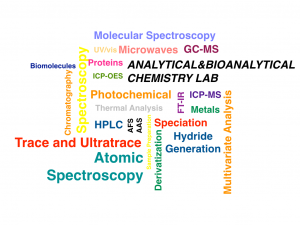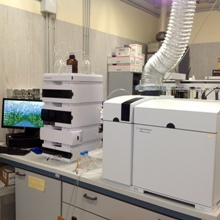Analytical and Bioanalytical Chemistry Laboratory (ABC-Lab)
 The analytical and bioanalytical chemistry research group operates at CNR-ICCOM in Pisa. The group has a long experience in spectroscopic techniques (atomic absorption and fluorescence spectrometry, infrared spectroscopy, Raman, light scattering, molecular fluorescence and UV-vis spectroscopy), chromatography (liquid chromatography and gas chromatography), and hyphenated techniques based on conventional detectors (UV, visible, fluorescence, mass spectrometry, atomic absorption spectrometry) and unconventional (atomic fluorescence and on-line measurement of surface tension and viscosity).
The analytical and bioanalytical chemistry research group operates at CNR-ICCOM in Pisa. The group has a long experience in spectroscopic techniques (atomic absorption and fluorescence spectrometry, infrared spectroscopy, Raman, light scattering, molecular fluorescence and UV-vis spectroscopy), chromatography (liquid chromatography and gas chromatography), and hyphenated techniques based on conventional detectors (UV, visible, fluorescence, mass spectrometry, atomic absorption spectrometry) and unconventional (atomic fluorescence and on-line measurement of surface tension and viscosity).
The group is a pioneer in the development, implementation and validation of new methodologies and instrumental devices for the determination and characterization of trace elements, trace, and ultra-trace compounds in biological, clinical, foods, environmental samples and in organic and inorganic materials with chemical and photochemical generation coupled with atomic spectrometry and mass spectrometry. The group is also involved in the development of methods for the analysis of proteins, amino acids and metabolites in biological fluids, cell cultures and biomaterials. In agreement with the principles of green analytical chemistry, the development of methods aim to replace aggressive reagents with solvent-free and environmentally friendly substances and procedures.
In the “green chemistry” area, a considerable activity of the group concerns the multi-technical characterization of polymers, biomaterials and protein materials deriving from the recovery of waste materials (keratin, collagen) and newly synthesized materials, in view of making a scientific contribution in the circular economy. The group is active in the development of methods for the extraction of polyphenols, bioactive substances and proteins from waste materials based on the use of ultrasound, microwaves, DES (Deep Eutectic Solvents) and NADES (Natural Deep Eutectic Solvents).
Furthermore, the group actively collaborates with other researchers of ICCOM Pisa for: i) the characterization of heterogeneous catalysts and nanostructured metallic materials and the development of their synthesis using innovative methods (Claudio Evangelisti) and ii) the characterization of new materials of interest in “desalination”, thermochemical storage and air conditioning – humidification and dehumidification (Angelo Freni).
Analyte derivatization techniques are appropriately combined offline or online with chromatographic systems (GC or LC) and spectroscopic (UV / visible, atomic absorption, atomic and molecular fluorescence, FTIR, optical ICP and ICP-MS) and rheometric (dynamic detector surface tension and viscosity) detectors (hyphenated systems) for the analysis and characterization of complex matrices.
The group actively collaborates with:
- The Metrology laboratory of the National Research Council of Ottawa (Canada) and the Institute of Analytical Chemistry of the Czech Academy of Sciences Department of Trace Element Analysis (Praha) for the development of highly accurate analysis methods and for the study of derivatization by borane complexes.
- The Department of Chemistry of the University of Washington (Seattle, WA) for the activity connected with the development of a dynamic surface tension detector for the analysis of proteins and polymers
- Institute of Neuroscience of CNR Pisa for metabolomic studies on cells subjected to stressors.
- Institute of Marine Biology and Ecology (Piombino, LI) concerning environmental monitoring
- INO CNR Pisa for the studies of new methods of extraction of polyphenols and bioactive substances.
- University of Edinburgh, School of Engineering, Mediterranean University of Reggio Calabria and Politecnico di Milano for studies on new materials for desalination, thermochemical storage and air conditioning (humidification and dehumidification).
- University of Pisa, Department of Chemistry and Industrial Chemistry and Department of Engineering for the recovery of proteins and polyphenols from waste material.

Areas of application
- Process Analytical chemistry
- Environmental monitoring
- Protein chemistry
- Clinical chemistry
- Metabolomics
- Characterization of materials and biomaterials
- Microwave and ultrasound extraction techniques
- Cultural heritage
- Determination and speciation of trace and ultra-trace metals (mercury, selenium, arsenic …) in raw matrices
- Mechanisms of hydrolysis of borane-complexes, generation of hydrides and hydrogen transfer
- New derivatization techniques for CG-MS and LC
Expertise
- Spectrochemical methods: atomic, UV-Vis, FT-IR, Raman spectroscopies, mass spectrometry
- Chromatographic techniques: GC, HPLC (SEC, GPC, RPC, HIC, IC), GC-MS
- Chemometry
- Microwave technology
- Thermoanalytical techniques (DSC, dynamic mechanical analyser, TGA)
- Hyphenated techniques:
- Chemical Vapor Generation (CVG) /Atomic Spectrometry- Mass Spectrometry
- Photochemical Generation / Atomic Spectrometry- Mass Spectrometry
- In-line UV / Microwave oxidation of the sample
- GC / HPLC Spectrometry
- HPLC/ICP-MS
- HPLC / Dynamic Surface Tension Detector

Instruments
- MW FKV Milestone StartD Digester with temperature control
- Eppendorf 5804R Centrifuge and freeze dryer
- Perkin Elmer Spectrum 100 FTIR spectrophotometer equipped with ATRU and Perkin Elmer Frontiers
- Jasco V-750 UV / Visible Spectrophotometer
- Horiba FluoroMax-4 spectrofluorimeter
- DSC7 Perkin Elmer; DMA 7e Perkin Elmer; TG / DTA 7200 Exstar.
- 2 ThermoFinnigan HPLC systems with gradient pump (P2000 and P4000), UV-Visible Diode Array detector (UV6000) and fluorescence detector (FL3000,) and microbore HPLC pumps (Jasco) for on line derivatization.
- Agilent 1260 Infinity HPLC (G1311B quaternary pump) equipped with Infinity High Performance Degasser, Agilent UV DAD / vis diode array (1260 DAD G4212B) and fluorimetric detector.
- Agilent Technologies 1260 Infinity GPC with refractive index detector
- 6850 CG / MS gas chromatograph coupled with 5975C MSD mass detector (Agilent Technologies, Milan, Italy)
- Generation of hydrides coupled to AAS Perkin Elmer 2380 spectrometer
- 1 prototype of atomic fluorescence spectrometers (AFS) with chemical vapor generation (CVG), flow injection (FIA) or coupling with HPLC.
- A prototype of a dynamic surface tension detector (DSTD) for the analysis of surfactants, proteins and water-soluble polymers using flow injection techniques (FIA) and HPLC
- Perkin Elmer Optima 8000 OES ICP spectrometer
- Direct mercury analyzer (DMA 80, Milestone)
- Agilent Technologies 7700 Series MS ICP
Permanent Staff
- Emilia Bramanti, Research Director
- Emanuela Pitzalis, Senior Researcher
- Beatrice Campanella, Researcher
- Massimo Onor, Lab Technician
- Simona Biagi, Lab Technician
